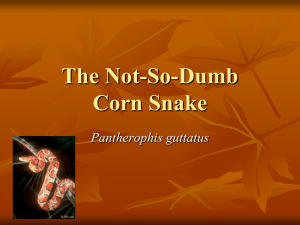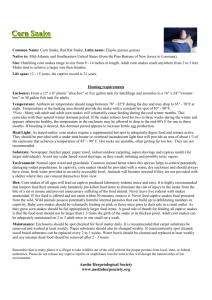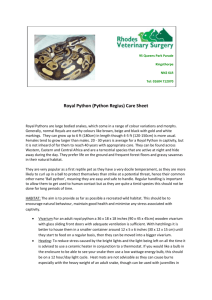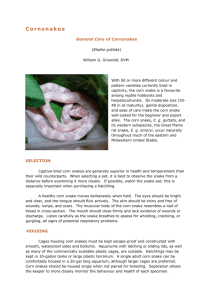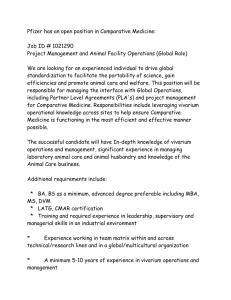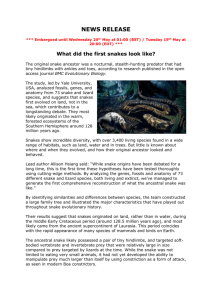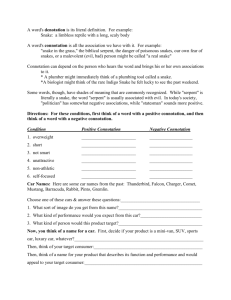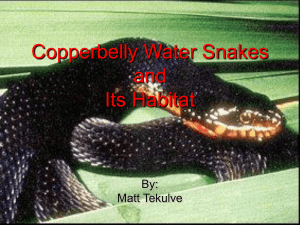Corn Snake vet advice - rhodes-vets
advertisement
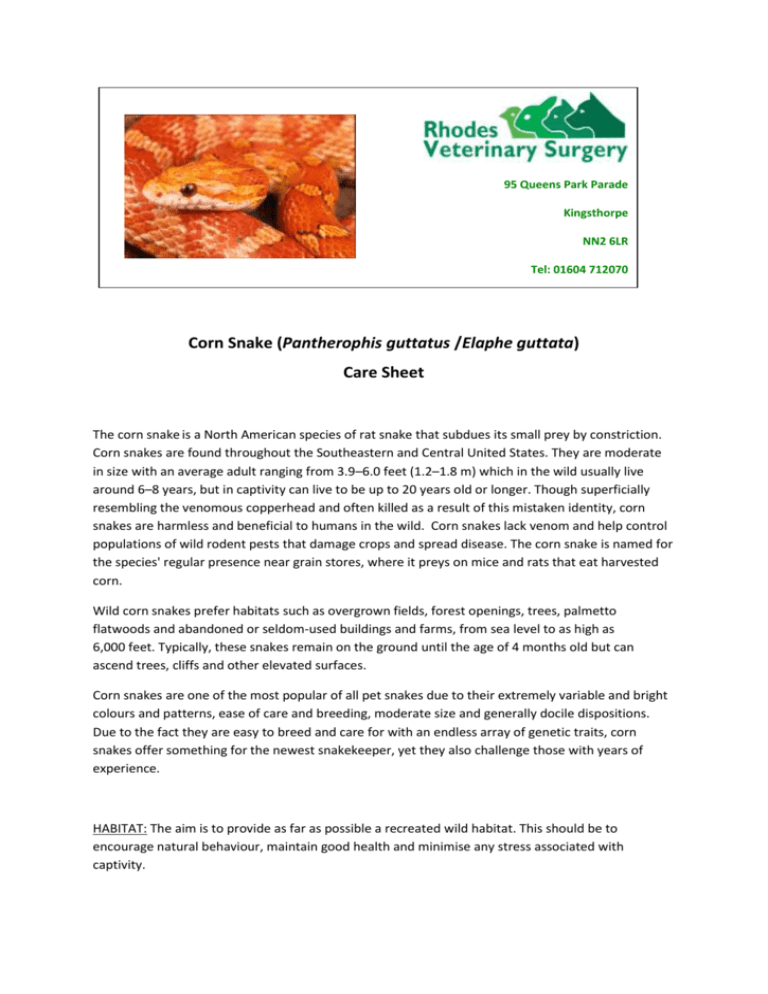
95 Queens Park Parade Kingsthorpe NN2 6LR Tel: 01604 712070 Corn Snake (Pantherophis guttatus /Elaphe guttata) Care Sheet The corn snake is a North American species of rat snake that subdues its small prey by constriction. Corn snakes are found throughout the Southeastern and Central United States. They are moderate in size with an average adult ranging from 3.9–6.0 feet (1.2–1.8 m) which in the wild usually live around 6–8 years, but in captivity can live to be up to 20 years old or longer. Though superficially resembling the venomous copperhead and often killed as a result of this mistaken identity, corn snakes are harmless and beneficial to humans in the wild. Corn snakes lack venom and help control populations of wild rodent pests that damage crops and spread disease. The corn snake is named for the species' regular presence near grain stores, where it preys on mice and rats that eat harvested corn. Wild corn snakes prefer habitats such as overgrown fields, forest openings, trees, palmetto flatwoods and abandoned or seldom-used buildings and farms, from sea level to as high as 6,000 feet. Typically, these snakes remain on the ground until the age of 4 months old but can ascend trees, cliffs and other elevated surfaces. Corn snakes are one of the most popular of all pet snakes due to their extremely variable and bright colours and patterns, ease of care and breeding, moderate size and generally docile dispositions. Due to the fact they are easy to breed and care for with an endless array of genetic traits, corn snakes offer something for the newest snakekeeper, yet they also challenge those with years of experience. HABITAT: The aim is to provide as far as possible a recreated wild habitat. This should be to encourage natural behaviour, maintain good health and minimise any stress associated with captivity. Vivarium Corn Snakes are not highly active and do not need huge enclosures. For an adult corn snake or groups you will need a 36 x 18 x 18 inches (90 x 45 x 45cm) wooden vivarium with glass sliding front doors with adequate ventilation, for a small corn snake a 24 x 15 x 12 inches (60 x 37.5 x 30cm) vivarium . With hatchlings it is better to house them in a smaller container around 12 x 5 x 6 inches (30 x 12 x 15 cm) until they start to feed on a regular basis, then they can be moved into a bigger vivarium. Heating: The vivarium temperature should be 20-30°C (70-88°F) during the day, with a night-time temperature of 20-25*C (68-77*F). This can be provided by a thermostatically controlled heat mat under a third to half the vivarium floor, 24 hours a day and a heat bulb supplying the extra basking heat and lighting during the day on a 10-14 days light cycle. Wire mesh guards should be fitted over all heat sources used within the vivarium to prevent thermal burns. There should be a temperature gradient from the basking site at one end of the enclosure to the other cooler end, enabling the snake to regulate its own temperature by moving around. Permanently position a thermometer at the basking area and at the cold end to be able to regularly monitor this temperature. Never assume the temperature on the thermostat is accurate. Vivarium Humidity/water Corn snakes do not require a specific humidity though it shouldn’t be too high as this can cause respiratory disease. Fresh clean water should be available at all times in a heavy based receptacle to allow access in and out without knocking over as often Corns like it to be big enough to climb in and bathe. Change daily. Provide in the cooler end of the vivarium away from the heat mat to help keep the vivarium humidity down. Furniture: Hide provisions in the vivarium are essential. Rocks/plastic plants for interest/climbing. Substrate: The most hygienic and safe option is newspaper or paper towel. Other substrates can be used such as beech chips can be used but be aware there is a small risk of accidental ingestion and gastrointestinal blockage. Feeding snakes in a separate container will help to avoid accidental substrate ingestion. U.V. LIGHT PROVISION: Corn snakes don't require UVB as they will get their calcium from the bones in their food, though some people like to have them for lighting and it may assist in breeding. CLEANING & DISINFECTION: Cleaning is not a replacement for disinfection. Many reptile bacteria can become opportunistic pathogens i.e. cause disease and being in a closed environment a build of parasites can occur. Disinfection is much more effective after thorough cleaning to remove dried organic debris. A reputable disinfectant (such as F10) should then be used as per instructions. Spot clean every time a motion is passed, with the vivarium fully cleaned and disinfected at once a month. DIET: As hatchlings, corn snakes should be fed weekly on defrosted pinky mice, as the snake grows the food size should be increased until the snake is taking large mice or even jumbos. Adult corn snakes can be fed once every two weeks as they can become overweight if fed weekly. Some snakes may be reluctant to feed, though this is more unusual in Corns, this may be due to unsuitable environmental conditions, seasonal changes (males may not eat during the breeding season; females will not eat while gravid or incubating eggs), stress (e.g. due to lack of a hide box, bright lights), because it is about to shed, or to medical problems. Try warming the food slightly before feeding, ‘braining’ the food by exposing brain tissue of the prey to improve smell or offering brown rodents such as gerbils or chicks. If using a chip substrate feeding snakes in a separate container will help to avoid accidental substrate ingestion. Do not handle your snake for a couple of days after feeding as this can cause regurgitaion. No specific supplementation is required. The quality of the food offered will have an effect upon the snakes nutrition so get from a reputable source. NEVER feed live prey, this is illegal in the UK and is dangerous to your snake. COMMON DISEASES: Respiratory disease; noise whilst breathing, elevated head position, mucus from mouth/nose, which can be fatal. Regurgitation: When a snake regurgitates it's meal, it may not necessarily be down to illness, but as regurgitation is a symptom of many digestive problems, illnesses and stress it is recommended that if your Corn Snake does regurgitate it's meal that you monitor your snake very closely for further symptoms. Sometimes a Corn Snake may regurgitate it's meal if it is handled too soon after a feeding or if it has been fed an item that is too large for it. In this case, you should leave the snake to settle back down for a week before trying to feed again. If your Corn Snake repeatedly regurgitates it's meal, loses excessive weight or shows any other signs that are worrying you, seek medical attention as soon as possible. Shedding problems; especially over the eyes, important to ensure adequate misting/hydration or bathing around times of shedding. Mites; often black (snake mite) or dark red (lizard mite) in colour. These can be very difficult to eradicate. PREVENTATIVE CARE AND DISEASE MANAGEMENT: Quarantine all new snakes for at least 6 months in order to reduce the chance of transmitting diseases such as Ophidian Paramyxovirus infection (a fatal untreatable respiratory virus). During this period record normal patterns of eating, defaecating, weight gain and behaviour for each animal. We recommend a faecal parasite screen is undertaken at the vets as a routine measure and for all new additions. If your snake becomes unwell, for example any regurgitation, abnormal body position, decreased appetite or abnormal respiration, we would advise you seek prompt veterinary advice.
